So this dish is pretty much awesome.
I’m finding that I’ve slowed down on the haphazard jumping around through this book, and am trying to pay more regard to the seasons. At first I wanted to just attack the recipes that seemed most interesting (and doable), but slowing down a little is encouraging me to look more deeply into these things. This dish is the first one in the Alinea cookbook, and I think I’ve overlooked it specifically because I had no idea what “nasturtium” (which I pronounced in my head “nas-tur-TEE-um”) was, much less what it tasted like.
My good friend and Knower Of Obscure Things, Ken, corrected my pronunciation and pointed out that Nasturtium is regarded as a common weed in NZ. That very same day, in true Baader-Meinhof style, I walked home from work and suddenly noticed our street was lined with massive amounts of it. I picked a leaf from one and bit into it; it had a heady, horseradish/black peppery ‘presence’ (it’s a little like wasabi: there’s a heavy olfactory component). In the weeks since, I’ve been taking mental notes to the various locations around our apartment that I can poach this stuff.
In addition to the soup I made from the Nasturtium, there are several other disparate elements at work in this dish. The surf clams I found across the strait in Marlborough. Some google searching brought me to Cloudy Bay Clams; Lorraine was incredibly helpful in telling me about their fish, how they’re caught and cared for, how they’re delivered, etc. This recipe calls for, simply, “Surf Clams”. I’m not a marine biologist, but some searching around wikipedia implies that in the US, there’s just one ‘type’ of Surf Clam (the Atlantic Surf Clam). In NZ, we apparently rock the hell out of surf clams; Cloudy Bay offers 4 varieties in various shapes and sizes. I recall having a course once at Martin Boseley’s where they served a tasting platter of various types of clams. I totally loved this, and was pretty fascinated at how much variation there could be in them. Since Cloudy Bay offers a similar variety, I just told them I wanted a mixture of whatever they recommended for someone wanting to learn more about this. They offer overnight shipping via Courier Post, or they can air freight some clams to you SAME DAY! The air freight option seemed a little excessive for what ended up being 4 KGs of clams, but still, pretty rad.
The one service Cloudy Bay doesn’t offer is shucking the clams. I’ll be honest, this part scared me. I had visions of shell residue scattered everywhere in the kitchen, nicked butter knife blades sitting in the sink, me crying softly in the corner, a sad half-mauled clam limping sadly across the floor like some sort of tongue creature, licking the floor and tasting my inadequacy.
So I googled “How to shuck a clam”. You guys, YouTube is seriously awesome. I mean, sure I use it to watch videos on mudslides or waterfalls at work, but you can find “how to” videos about ANYTHING on youTube! Last year I got on a jag where I wanted to take more portraits of people, so I wanted to learn how to do makeup. You can find a squillion videos on youTube for doing smoky eyes, fake tattoos…or, as it turns out, how to shuck a clam. Awesome.
A day after I placed the order, I was delivered a box of perfectly happy clammies. What I ended up with was a sampler pack of Mactra (Trough Shell), Tuatua, and Moon Shell clams (the Diamond clams were temporarily out of stock). Armed with some false youTube confidence, I went about trying to shuck some of them. This went pretty ok, but not all-the-way awesome. The largest clams shucked very easily, as did the smallest, but the ‘medium-sized’ clams were tighter than the tightest tights in TightTown. Fabricating the largest clams, once shucked, also proved to be interesting. I thought the severing of the adductor muscles in the clams was supposedly enough to kill them (maybe it is), but they were squirming around well after I’d pried them completely loose of the shell. The recipe mentions refrigerating the clams in oil and salt for an unspecified time; I wonder if this is to give time for rigor mortis to set in and to allow the muscles to relax. I was bent on taking advantage of the freshness of these clams, so I just dipped them in oil before slicing them as directed and searing them in a grill pan. This didn’t go very well; the cut pieces seized up tightly for several seconds before finally relaxing, which led to a rubbery texture not to mention totally skeeving me out.
What I finally found to be both tasty and easier was using my propane torch to sear the outside of the clam; this left the inside still supple and not rubbery, while giving the clam a smoky roasted flavor. I imagine this is closer to what Chef Achatz is gunning for, though I can’t be positive.
Tucked beneath the surf clam is a shallot-cucumber marmalade, another concoction that in my head didn’t make much sense but once I tasted it I found delicious. In the photos of this dish in the book, there’s a glob of something kind of green and gelatinous resting on the fork just behind the marmalade. I at first assumed it was the marmalade itself, so I googled it. I found that indeed it was something else left omitted from this recipe; the errata for the book mentions a Lemon Pudding recipe from one of the salsafy dishes that could be used.
On reading this I almost immediately regretted googling it; I’d killed an opportunity to just make something up completely. I guess in hindsight it was a good thing: I didn’t know what the final dish was going to taste like, and would have had a hard time imagining what flavor might go well with these other unfamiliar things. So it was helpful to know that I needed something tangy and acidic, but I was still bent on trying to do something different. I haven’t seen Chef Achatz repeat any recipe in this book yet, so I found it suspicious that this one thing would be duplicated. Also, the glob in the photo in the book looks green, and the Lemon Pudding recipe in question yields something bright yellow, so I suspect something is different.
My dad has had a bourbon and coke every night after dinner for as long as I can remember. When I was a kid, I wanted to surprise him one night by making one for him. I filled a pint glass almost to the brim with bourbon, then added enough coke to roughly match the color that I recalled his drink being. I remember him taking a sip, coughing, and saying “MMMM!” in a pained tone.
This strategy of ‘screwing with something based completely on a visual representation of it’ worked out much better for me this time though: what I came up with was a Lime and Lemon-Thyme Pudding, which if I may say is damn delicious. I wanted it to be green, so I used lime zest, saffron, and (in a blatant cheat), blue food coloring. I wanted to use some kind of chlorophyll to get the green color, but couldn’t decide what herb or plant to juice for this that wouldn’t completely overshadow the lime, so I cheated, with a footnote that when I try this again I’ll think more about it. Is there a such thing as lime verbena? I’ve been growing some lemon thyme in my little herb garden, and it’s lemony with a little thymy je ne sais quois to it. In the end I think it turned into a brilliant success; the pudding is tangy and has more than one dimension, and best of all it matches the color of the photo in the book!
But how would it stack up in the final assembled dish? As it turns out, totally awesome. The Nasturtium Soup on it’s own is just way too much; it’s one-dimensional and very overbearing. But a forkful of cucumber/shallot marmalade and lime pudding mixed with the soup works brilliantly. The peppery-ness of the nasturtium is cut by the tang of the lime, and the sweetness of the marmalade balances the mix really well. I didn’t have the same experience as in other dishes where the flavors ‘unfold’, but they combine really nicely as one taste experience that’s hard to really articulate but still works perfectly. Magic.
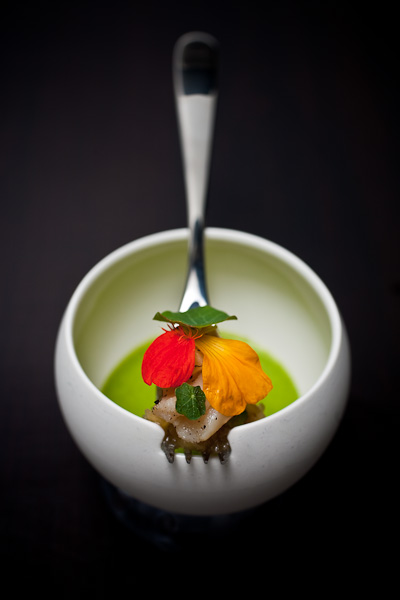
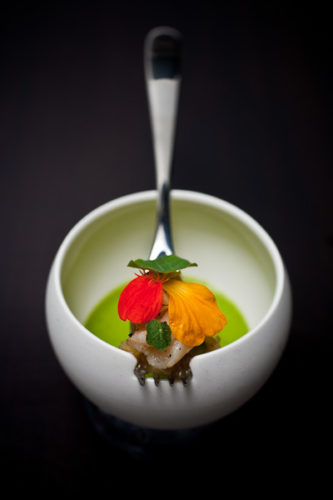
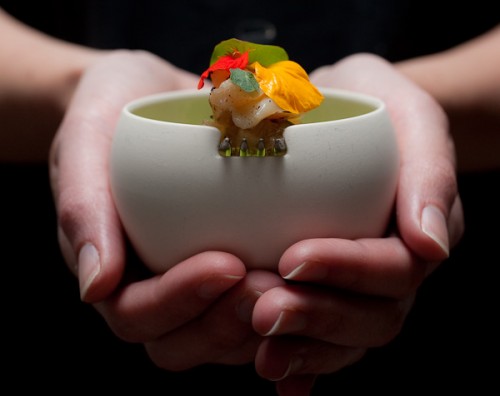
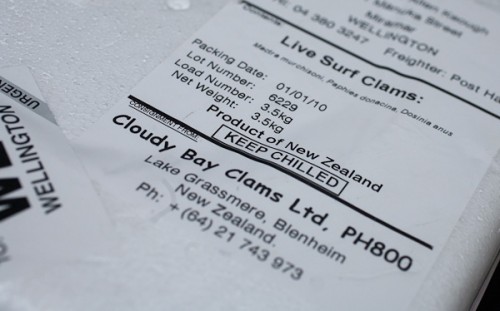
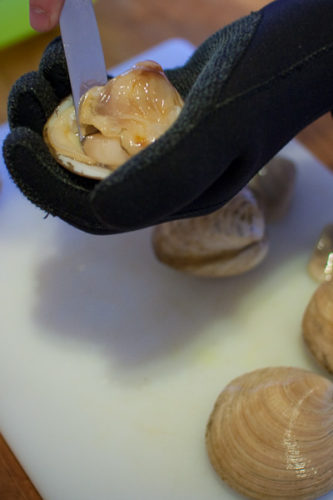
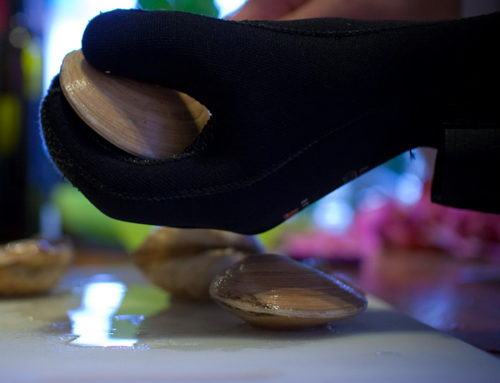
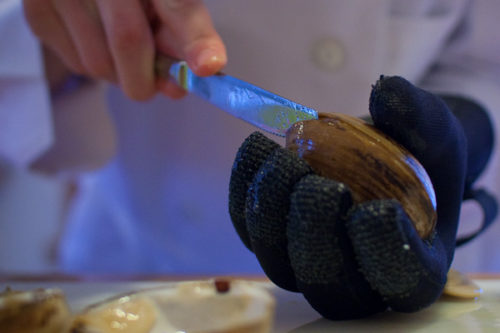
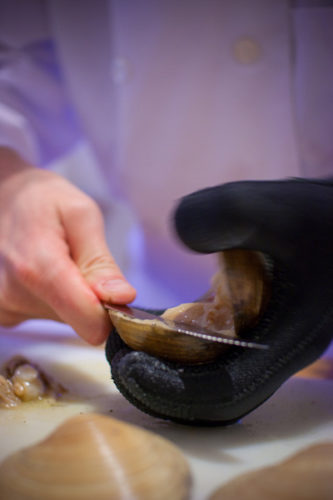
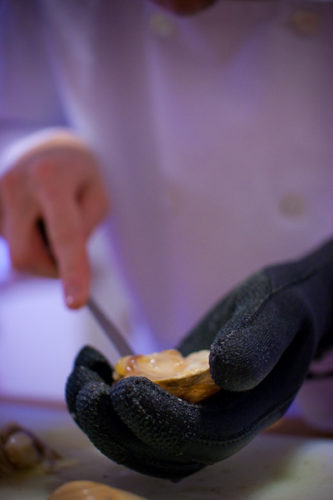

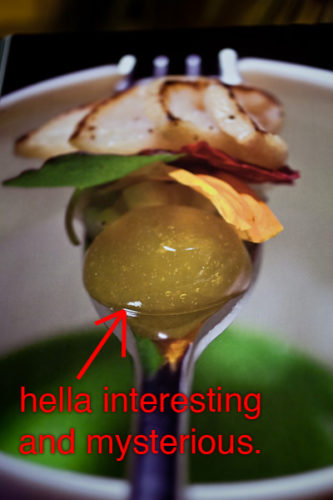

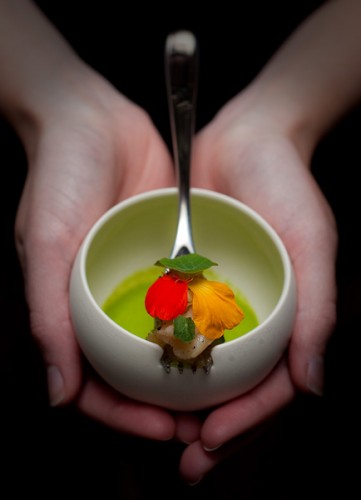
Great job on the continous posting and these photos look amazing.